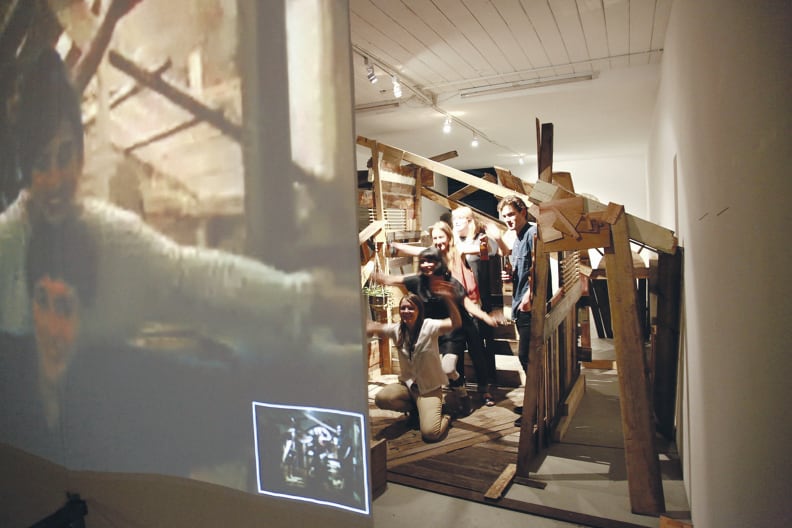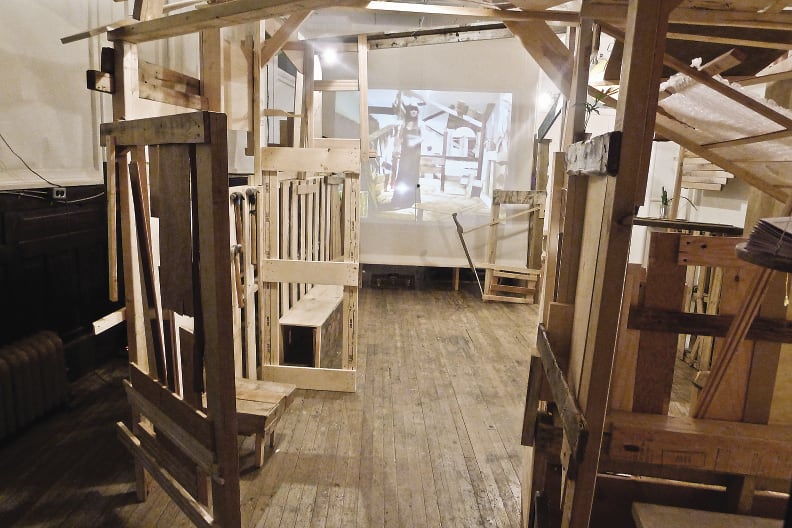
In March of this year at Rear View Gallery, Melbourne, and Artbank, Vancouver, Kate Moss and Marilyne Blais simultaneously constructed transient and temporal structures through the use of found materials, Skype, projectors and volunteers. We Build Up became a communal structure that was both a mirror of itself and a quixotic attempt to join architectural form through a shared space.
During August and September whilst I was in New York, Kate, Marilyne and I conducted the following conversation via email in much the same way that We Build Up was realised.
What is your connection to each other?
Kate came to Canada from Melbourne in the summer of 2010 to do a residency at the Banff Centre and while there, she met some of my friends and they drove down to Vancouver together. Kate used to live in Vancouver and we have quite a lot of friends in common.
Marilyne and I hit it off straight away; I was really interested in the projects she was working on. After I left Vancouver, we stayed in touch via email and began to discuss working on a project together. We Build Up took place once I was back in Melbourne and Marilyne was in Vancouver.
Skype seemed like a major element of the project. Have technology and communication devices helped your collaborative practice?
I don’t know if ‘helping’ is the right term. In the case of We Build Up we can say that technology was more of a necessity. In our practices, Kate and I favour earthy materials and manual labour, and we are influenced by folk art and handcrafted architecture. Both of us have very little interest in foregrounding the use of new media.
Technology facilitated the ability to work together within our individual environments; we wanted to work on a project that defied the boundaries of geography. Our initial idea was that people in Melbourne could engage with people in Vancouver to build together through the projection, to make one space out of two.

How difficult was it to collaborate through the screen?
From the start, Kate and I understood that the communication system we put in place would probably influence dynamics in unexpected ways. We consciously decided to have few expectations about how things would develop. The idea was to set up a situation without trying to control the outcomes.
There were some clear difficulties with the projection system: the sound was bad and the image was blurry at times. Our perspective of the other’s space was often deceptive given the screen’s propensity to flatten space.
I noticed on a number of occasions that people became self-conscious when walking into the gallery, seeing the screen and then people looking back at them. When both spaces were busy it would often become challenging to communicate and work. We were conscious of working alongside each other in our own spaces rather than working together. But we were always aware of the other’s presence.
Every now and then someone would say something or let out a victory scream and it would be echoed in the other space; there was a lot of echoing going on, both vocally and in gesture. Finding new ways to communicate was a constant form of entertainment — it definitely kept the morale up and the project fun.
To me, the most important aspect of the project was always relational. I wasn’t very concerned with the failure of the system we had worked out but rather with the way the system affected the relation between the participants.
The act of building was employed as a means to facilitate the opportunity for people in Melbourne to engage with people in Vancouver, to create a shared space through the projection. We had a visit from a group of students who really embraced the project. Rather than help build, they stood in front of the screen and chatted with people at Artbank.
How many people helped with this project? What were the difficulties in coordinating geographically separated work crews?
MB: The two spaces ended up working very differently from each other. Art Bank was smaller than Rear View and sort of out of the way in a more industrial part of the city. Because of this we had less people dropping by the gallery on a daily basis. In Vancouver, there was a regular group of participants, while in Melbourne there were more participants who attended on a less regular basis. Kate created strong relationships with the artists who were working at Artbank, while I didn’t really get a feel for the people who were working with her.
There is something so quixotic about the project, its structure and its inbuilt quality to never reach its potential. Was this a desired outcome?
The action and the process of building — making together and working together side by side through the screen — was always more important than the built structure. I guess it was quite idealistic in this sense.
Both of you live in cities that are growing at alarming rates, encroaching on native parklands, and constantly replacing old neighbourhoods and communities with new apartments and new communities. Were you trying to create new spaces to subvert the process of rapid gentrification?
We Build Up was never intended as a critique but I do think that we both are sensitive to the specific nature of our environment and the cities we live in. I am from the East Coast and, to me, Vancouver always read as a place that is very new and young. Living in a place that is evolving and changing so fast can feel threatening at times — there is a sense that certain things, places and groups are not valued. To consider preserving them is not a question because they don’t have a lot of weight in time. That kind of adversity can create a lot of dialogue because things are constantly changing and there is always a potential for ‘better’ change.
You guys built something that really has no basis in locale. It existed in Melbourne and Vancouver and on the internet but really never had a fixed location. How can architecture exist in a metaphysical structure?
I am not sure if it is that the installation had no location but more that it had multiple places of existence, similar to the way the project investigated the concept of community. I think that one of the most successful aspects of We Build Up was its lack of concrete direction and the absence of set rules. It helped people feel free to behave the way they wanted in the space and allowed people to be invested at -different levels, without forced participation. Indeed, anyone could pick up a hammer and join in. The architecture of the space developed in relation to this fact: it was organic and crafty and a bit haphazard. The only real function of the building was its social function. A lot of what we made ended up looking like ‘hang out’ spots.
Tim Hillier is a Melbourne-based photographer and filmmaker, who followed the We Build Up project from start to finish, visiting Kate every day to take photos and bring beers. He has contributed photos and text to Patterns of Creative Aggression, Higher Arc and Color magazine.
